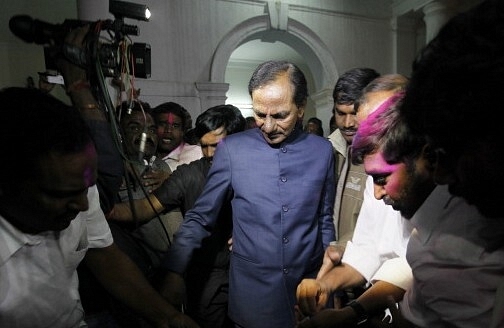Politics
No Such Thing As A Third Front: There Can Be Anti-BJP Or Anti-Congress Front, Not One Against Both
- For a Third Front to be viable, we need to see both national parties in long-term decline. That is far from being the case now.

K Chandrasekhar Rao in New Delhi. (Raj K Raj/Hindustan Times via GettyImages)
The idea of the Third Front is like the Loch Ness monster. A lot of people claim periodically to have sighted it, but its existence cannot be proven. And so it will be with K Chandrashekar Rao’s idea of a People’s Front, which analysts have dubbed the “Third Front”.
Let us get this clear: India has never had, and probably will never have in the foreseeable future, anything called the Third Front. What is called Third Front is essentially a Second Front, one where one of the two national parties (BJP or Congress) allows parties with a small number of MPs to run a government for a while. The Second Front is essentially a front against the dominant national party at the Centre, nothing more.
In the past, the Second Front included all regional and national parties (including the BJP’s predecessor Jana Sangh) that wanted a non-Congress government at the Centre (or in some states). The Janata Party of 1977 was a non-Congress Second Front. The short-lived V P Singh government was an anti-Congress front supported by both the BJP and the Left from the outside. The United Front governments of 1996 and 1998 were an anti-BJP front supported by the Congress from the outside.
The point is simple: if any front needs either the Congress or the BJP to stay in power, there is no Third Front. It is just a temporary Second Front.
A Third Front is an impossibility as long at the Congress and the BJP, between them, garner more than 272 seats. But this has never happened in the past. For a viable Third Front to form, you need both the parties to collectively decline below this mark to allow the rest to arithmetically garner 272. The closest this came to happening was in 2004, when the combined Congress-BJP total was at 283. If either party had lost just six seats each, a Third Front without either of them would have been technically possible, but it would not have had longevity. Reason: you would need to get just one major regional party out to crash the government. A situation in which every significant regional party can pull the government down in a Third Front means that the idea is unviable except as a short-term measure.
In 2019, assuming the BJP were to slide to around 200 seats, and the Congress fails to cross 70 seats, a Third Front can theoretically be formed. But it cannot survive for long as its internal contradictions would sooner or later overwhelm it. For example, can you see the Trinamool Congress and Communist Party of India-Marxist having the same outlook in this coalition when a state election looms? Or the Dravida Munnetra Kazhagam and All India Anna Dravida Munnetra Kazhagam, or the Telugu Desam and the YSR Congress?
Here’s the takeout: for a Third Front to be viable, we need to see both national parties in long-term decline. That is far from being the case now.
Introducing ElectionsHQ + 50 Ground Reports Project
The 2024 elections might seem easy to guess, but there are some important questions that shouldn't be missed.
Do freebies still sway voters? Do people prioritise infrastructure when voting? How will Punjab vote?
The answers to these questions provide great insights into where we, as a country, are headed in the years to come.
Swarajya is starting a project with an aim to do 50 solid ground stories and a smart commentary service on WhatsApp, a one-of-a-kind. We'd love your support during this election season.
Click below to contribute.
Latest